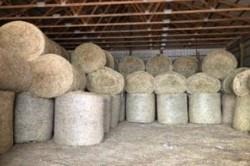By Eric Richer
For many farmers and ranchers, on-farm storage is a key part of a comprehensive commodity marketing plan and improved feed storage. University research and practical experience has shown that forage feed quality is significantly better and storage losses are much lower when stored inside out of the weather (see Hay Storage Considerations, OSU 21-96 Fact Sheet).

On farm hay storage is eligible for low interest financing through FSA
A unique farm program administered through the Farm Service Agency (FSA) is the Farm Storage Facility Loan (FSFL) program. FSA is part of the U.S. Department of Agriculture (USDA) which uses this program to provide low-interest financing for producers to store, handle, and/or transport eligible commodities they produce. Many livestock and/or forage producers do not realize that flat storage and bunker-type storage structures are eligible as well as the associated trucks and handling equipment. Overall, the list of eligible commodities, facilities, equipment, and upgrades is quite impressive. Generally, they include the following:
- Acquiring, constructing or upgrading new or used, portable or permanently affixed, on-farm storage and handling facilities.
- Acquiring new or used storage and handling trucks; and
- Acquiring new or used permanently affixed storage and handling equipment.
A producer may borrow up to $500,000 per loan, with a minimum down payment of 15 percent. Loan terms are 3 to 12 years, depending on the amount of the loan. The May 2022 interest rate for all term lengths of the FSFL program is 2.625%. Producers must demonstrate storage needs based on three years of production history. FSA also provides a microloan option that, while available to all eligible farmers and ranchers, also should be of particular interest to new or small producers where there is a need for financing options for loans up to $50,000 at a lower down payment (5 percent) with reduced documentation. There is a nonrefundable $100 application fee per borrower for this program.
Who is eligible?
An eligible borrower is any person who is a landowner, landlord, leaseholder, tenant or sharecropper. Eligible borrowers must be able to show repayment ability and meet other requirements to qualify for a loan. Contact an FSA office for more details. Eligible storage structures and handling equipment, having a useful life for the entire term of the loan, may be permanently affixed or portable. Facilities built for commercial purposes and not for the sole use of the borrower(s) are not eligible for financing.
Eligible Commodities
The following commodities are eligible:
- Corn, grain sorghum, rice, soybeans, oats, peanuts, wheat, barley, or minor oilseeds harvested as whole grain;
- Corn, grain sorghum, wheat, oats or barley harvested as other-than-whole grain and malted small grains
- Other grains (triticale, rye, speltz, and buckwheat) and pulse crops (lentils, chickpeas and dry peas);
- Hay, honey, hops, hemp;
- Renewable biomass;
- Floriculture;
- Fruits (includes nuts) and vegetables – cold storage facilities;
- Maple sap and syrup;
- Milk, cheese, butter, yogurt;
- Eggs and meat/poultry (unprocessed);
- Aquaculture;
- Seed cotton;
Eligible Facilities, Equipment and Upgrades
The following types of new/used facilities and upgrades are eligible and must have a useful life for at least the term of the loan:
- Conventional cribs or bins;
- Oxygen-limiting structures and remanufactured oxygen-limiting structures;
- Flat-type storage structures;
- Electrical equipment and handling equipment, excluding the installation of electrical service to the electrical meter;
- Safety equipment, such as interior and exterior ladders and lighting;
- Equipment to improve, maintain or monitor the quality of stored grain;
- Concrete foundations, aprons, pits and pads, including site preparation, off-farm labor and material, essential to the proper operation of the grain storage and handling equipment;
- Renovation of existing farm storage facilities, under certain circumstances, if the renovation is for maintaining or replacing items;
- Concrete foundations, aprons, pits and pads, including site preparation, off-farm labor and material, essential to the proper operation of the grain storage and handling equipment;
- Renovation of existing farm storage facilities, under certain circumstances, if the renovation is for maintaining or replacing items;
- Grain handling and grain drying equipment determined by the Commodity Credit Corporation to be needed and essential to the proper operation of a grain storage system (with or without a loan for the storage facility);
- Structures that are bunker-type, horizontal or open silo structures, with at least two concrete walls and a concrete floor;
- Structures suitable for storing hay built according to acceptable design guidelines;
- Structures suitable for storing renewable biomass;
- Bulk tanks for storing milk or maple sap;
- Cold storage buildings, including prefabricated buildings that are suitable for eligible commodities. May also include cooling, circulating and monitoring equipment and electrical equipment, including labor and materials for installation of lights, motors and wiring integral to the proper operation of a cold storage facility; and
- Storage and handling trucks, including refrigerated trucks.
- Other equipment options are eligible, please consult with your local FSA office.
Environmental Evaluation, Financial Review and Crop Insurance
Before a FSFL is approved, the building site must have a comprehensive environmental evaluation. FSA will request a review of the applicant’s farm finances, similar to that your lending institution; if approved, FSA will hold the first lien on the property purchased.
FSA will also require the applicant/farm to carry a minimum level of crop insurance for the eligible commodity(s) in question.
Finally, these loans must be approved by the local FSA state or county committee before any site preparation and/or construction can be started.
Source : osu.edu